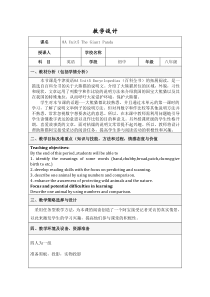 DOC
DOC
【文档说明】《Unit 5 Encyclopaedias》教学设计3-八年级上册英语【牛津上海版】.docx,共(4)页,20.873 KB,由小喜鸽上传
转载请保留链接:https://www.ichengzhen.cn/view-102184.html
以下为本文档部分文字说明:
教学设计课名8AUnit5TheGiantPanda授课人学校名称科目英语学段初中年级八年级一、教材分析(包括学情分析)本节课是牛津英语8AUnit5Encyclopedias(百科全书)的拓展阅读,是一篇选自百科全书的关于大熊猫的说明文。介绍了大熊猫居住的区域,外貌,习性和现状
。文章运用了列数字和作比较的说明方法来介绍我国的国宝大熊猫以及其在我国的特殊地位。从而呼吁大家爱护环境,保护大熊猫。学生对本节课的话题---大熊猫都比较熟悉,并且通过本单元的第一课时的学习,了解了说明文举例子的说明方法。但对列数字和作比较等其他说明方法并不熟悉,常常忽视数字想要表
达的意思。所以,在本课中教师需利用问题链引导学生读懂数字表达的意思以及作比较的目的和意义。另外授课班级的学生性格开朗,喜爱故事类的文章,面对枯燥的说明文常常提不起兴趣。所以,教师将设计帮助熊猫阿宝接受采访的阅读任务,提高学生
参与阅读活动的积极性和兴趣。二、教学目标及难重点(知识与技能,方法和过程,情感态度与价值Teachingobjectives:Bytheendofthisperiod,studentswillbeab
leto1.identifythemeaningsofsomewords(band,chubby,broad,patch,clumsy,givebirthtoetc.)2.developreadingskillswiththefocusonpredictin
gandscanning.3.describeoneanimalbyusingnumbersandcomparison.4.enhancetheawarenessofprotectingwildanimalsandthenature.Focusan
dpotentialdifficultiesinlearning:Describeoneanimalbyusingnumbersandcomparison.三、教学策略选择与设计采用任务型教学方法,为本课的阅读创造了一个阿宝接受记者采访的真
实情景,以此来激发学生的学习兴趣,提高他们参与课堂的积极性。四、教学环境及设备、资源准备四人为一组准备黑板,投影,实物投影五、教学过程教师活动学生活动设计意图Lead-inGivestudentssomecluesandletth
emguesswhichcartooncharactertheteacheristalkingabout.Pre-readingAskstudentstoguesswhatinformationtheycange
tfromthearticle.While-reading1.Letstudentsreadthewholetextandfindoutthemainideaofeachparagraph.2.Showthest
udentsamapofChinaandaskthemtofindoutwhichplacethegiantpandalivesin.3.AskstudentstofindoutthethreefeaturesofthegiantpandainParagraph1.Lead-inListe
ntothecluescarefullyandguesswhichcartooncharactertheteacheristalkingabout.Pre-readingGuesswhatinformationth
eycangetfromthearticle.While-reading1.Readthewholetextandfindoutwhatinformationaboutthegiantpandatheyc
angetfromthearticle.2.Readparagraph1andfindoutwhichplacethegiantpandalivesin.3.Readparagraph1andcycle
outthethreefeaturesofthegiantLead-inToelicitthetopicandteachstudentsthenewwords.Pre-readingTohelpstudentspredictthemai
nideaofthetext.While-reading1.Tohelpstudentsgetthemainideaofeachparagraph.(livingarea,appearance,behav
iour,food,situation)2.Todevelopstudents’skillsofreadingforspecificinformation.3.Tohelpstudentfindoutthefeaturesofthegi
antpanda.4.Askstudentstounderlinethesentenceswhichcanshowthatthegiantpandaisalargeanimal.5.Letstudentsreadparagraph2andcorrectthemista
kesofthecommonpointsbetweenthegiantpandaandthebear.6.Showapictureofagiantpandaandletstudentscompletethenotesofthepictureafterreadin
gparagraph2again.7.Askstudentstothinkaboutwhichpartofthegiantpandaisdescribedfirst.8.Askstudentstoanswert
woquestionsaskedbyPothroughreadingparagraph3,4.Post-reading1.Letstudentsroleplaythepanda.4.Readparagraph2andunderlinethesentencesw
hichcanshowthatthegiantpandaisalargeanimal.5.Readparagraph2againandcorrectthemistakesofthecommonpointsbetweenthegian
tpandaandthebear.6.Readparagraph2forthethirdtimeandcompletethenotesofapicture.7.Findouttheorderofthedescription8.Answe
rPo’stwoquestionsbyreadingparagraph3,4.Post-reading1.Roleplayaninterview4.Tohelpstudentsbetterunderstandtheusesofnumbers5.Tohelpstudentsknowtheusesof
comparison.6.Tohelpstudentsunderstandhowtodescribetheappearanceofthegiantpanda.7.Tohelpstudentsunderstandtheorderofthedescription:fromthelargepa
rttothesmallpart.8.Todevelopstudents’skillsofreadingforspecificinformation.Post-reading1.Toletstudentsuseintervie
wbetweenthereporterandPo.2.Askstudentstowriteaself-introductionforFuriousFiveingroupsaccordingtothechecklist.
3.Askthestudentstochoosethebestself-introduction.inpairs.2.Writeaself-introductionforFuriousFiveingroupsaccordingtothecheck
list.3.Choosethebestself-introduction.thepatternsthey’velearnttomakedialogues.2.Tohelpstudentspracticehowto
describeananimal.3.Helpstudentsdeveloptheircriticalthinking.六、教学评价设计Homework1.FinishtheexerciseA&BonP852.Choos
eoneanimalfromFuriousFive.Useencyclopediaandwriteanintroductionaboutitwith80words.3.RecitethetextonP85.七、课后反思通过创设阿宝接受
电视台采访的情景,学生对于文章的阅读兴趣非常浓厚,参与学习的积极性也很强。通过预测,学生带着问题阅读整篇文章,很轻松得把握到了文章的大意,了解作者从五个方面介绍大熊猫,并且为接下来的扫读做好了铺垫。课堂中问题链的使用,帮助学生抓住了大熊猫的三个特征,通
过解读数字,比较共同点,揣摩描写顺序,学生不仅清晰得了解了大熊猫的外貌特征,生活习性和生存现状,更深刻得体会了说明文的写作手法。最后的读后活动不仅给学生创造了综合运用所学语言知识和技能的机会,还培养了他们的创新思维和批判性思维。但读中活动的最后一步
,学生阅读文本的时间过短,对文本的解读不够深刻,学生没有机会深入思考为什么大熊猫会变得非常稀有,因此学生对大熊猫面临的困境理解不够,保护环境的意识没有被彻底激发。
 辽公网安备 21102102000191号
辽公网安备 21102102000191号
 营业执照
营业执照